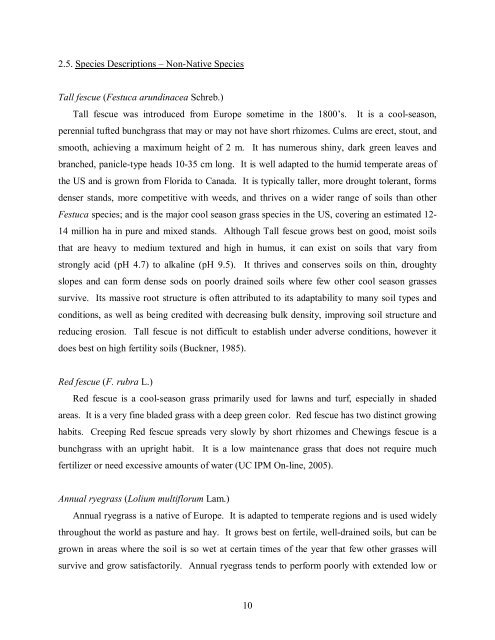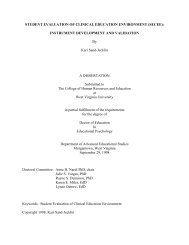The Use of Native Plants for Revegetation along West Virginia ...
The Use of Native Plants for Revegetation along West Virginia ...
The Use of Native Plants for Revegetation along West Virginia ...
Create successful ePaper yourself
Turn your PDF publications into a flip-book with our unique Google optimized e-Paper software.
2.5. Species Descriptions – Non-<strong>Native</strong> Species<br />
Tall fescue (Festuca arundinacea Schreb.)<br />
Tall fescue was introduced from Europe sometime in the 1800’s. It is a cool-season,<br />
perennial tufted bunchgrass that may or may not have short rhizomes. Culms are erect, stout, and<br />
smooth, achieving a maximum height <strong>of</strong> 2 m. It has numerous shiny, dark green leaves and<br />
branched, panicle-type heads 10-35 cm long. It is well adapted to the humid temperate areas <strong>of</strong><br />
the US and is grown from Florida to Canada. It is typically taller, more drought tolerant, <strong>for</strong>ms<br />
denser stands, more competitive with weeds, and thrives on a wider range <strong>of</strong> soils than other<br />
Festuca species; and is the major cool season grass species in the US, covering an estimated 12-<br />
14 million ha in pure and mixed stands. Although Tall fescue grows best on good, moist soils<br />
that are heavy to medium textured and high in humus, it can exist on soils that vary from<br />
strongly acid (pH 4.7) to alkaline (pH 9.5). It thrives and conserves soils on thin, droughty<br />
slopes and can <strong>for</strong>m dense sods on poorly drained soils where few other cool season grasses<br />
survive. Its massive root structure is <strong>of</strong>ten attributed to its adaptability to many soil types and<br />
conditions, as well as being credited with decreasing bulk density, improving soil structure and<br />
reducing erosion. Tall fescue is not difficult to establish under adverse conditions, however it<br />
does best on high fertility soils (Buckner, 1985).<br />
Red fescue (F. rubra L.)<br />
Red fescue is a cool-season grass primarily used <strong>for</strong> lawns and turf, especially in shaded<br />
areas. It is a very fine bladed grass with a deep green color. Red fescue has two distinct growing<br />
habits. Creeping Red fescue spreads very slowly by short rhizomes and Chewings fescue is a<br />
bunchgrass with an upright habit. It is a low maintenance grass that does not require much<br />
fertilizer or need excessive amounts <strong>of</strong> water (UC IPM On-line, 2005).<br />
Annual ryegrass (Lolium multiflorum Lam.)<br />
Annual ryegrass is a native <strong>of</strong> Europe. It is adapted to temperate regions and is used widely<br />
throughout the world as pasture and hay. It grows best on fertile, well-drained soils, but can be<br />
grown in areas where the soil is so wet at certain times <strong>of</strong> the year that few other grasses will<br />
survive and grow satisfactorily. Annual ryegrass tends to per<strong>for</strong>m poorly with extended low or<br />
10












